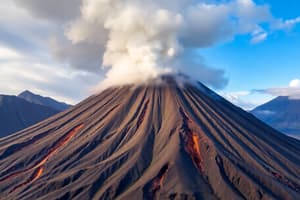Podcast
Questions and Answers
What is the main function of the conduit in a volcano?
What is the main function of the conduit in a volcano?
- To prevent volcanic debris from escaping
- To store the accumulated magma before eruption
- To allow gases to escape from the volcano
- To provide a pathway for magma to flow to the surface (correct)
Which type of volcanic eruption is characterized by jet-like eruptions of lava reaching great heights?
Which type of volcanic eruption is characterized by jet-like eruptions of lava reaching great heights?
- Explosive eruptions
- Strombolian eruptions
- Lava flow eruptions
- Lava fountain eruptions (correct)
What is the main difference between a crater and a caldera in terms of volcanic structures?
What is the main difference between a crater and a caldera in terms of volcanic structures?
- A crater is deeper than a caldera
- A caldera is formed by the accumulation of volcanic debris
- A caldera is located at the summit of a volcano, while a crater is at the base
- A crater is formed by the collapse of sidewalls, while a caldera is larger and more subsided (correct)
Which type of volcanic eruption is known for creating slow, viscous lava flows that result in flat surfaces?
Which type of volcanic eruption is known for creating slow, viscous lava flows that result in flat surfaces?
What distinguishes a lava fountain eruption from a strombolian eruption?
What distinguishes a lava fountain eruption from a strombolian eruption?
What type of eruption is characterized by steam-driven explosions creating columns of ash and debris?
What type of eruption is characterized by steam-driven explosions creating columns of ash and debris?
Which type of volcano is known for its low-profile shape with gentle slopes formed by the extrusion of fluid lava?
Which type of volcano is known for its low-profile shape with gentle slopes formed by the extrusion of fluid lava?
What defines an active volcano?
What defines an active volcano?
Which type of volcanic eruption is associated with the launch of massive clouds of ash and debris high into the atmosphere?
Which type of volcanic eruption is associated with the launch of massive clouds of ash and debris high into the atmosphere?
What type of volcano forms from the accumulation of pyroclastic material and is characterized by its small, steep-sided structure?
What type of volcano forms from the accumulation of pyroclastic material and is characterized by its small, steep-sided structure?
Flashcards are hidden until you start studying
Study Notes
The Many Faces and Eruptions of Earth's Volcanic Wonders
Volcanoes are complex systems of the Earth, with diverse structures, activities, and eruptions that have captured our imaginations for centuries. Understanding these facets of volcanism sheds light on our planet's dynamic processes and helps us anticipate and prepare for the potent forces that shape our world.
Structures of Volcanoes
Volcanoes typically consist of five main components:
- Magma chamber – A reservoir of molten rock beneath the Earth's surface where magma accumulates before eruption.
- Conduit – A vertical pathway connecting the magma chamber to the surface.
- Vent – The opening at the volcano's surface through which magma, ash, and gases escape.
- Crater – A depression at the summit of a volcano, formed by the collapse of the volcano's sidewalls or by the accumulation of volcanic debris.
- Caldera – A larger, more subsided version of a crater, typically occurring when magma is withdrawn from a volcano's chamber, causing the ground to collapse.
Types of Volcanic Eruptions
Volcanic eruptions are classified based on their style and intensity:
- Lava flow eruptions – Slow, viscous lava flows, creating flat surfaces.
- Lava fountain eruptions – Jet-like eruptions of lava that can reach heights of up to several thousand meters.
- Strombolian eruptions – Explosive eruptions characterized by the ejection of blocks and bombs.
- Vulcanian eruptions – Steam-driven explosions that create columns of ash and debris.
- Plinian eruptions – Violent explosive eruptions that launch massive clouds of ash and debris high into the atmosphere.
- Pelean eruptions – Explosive eruptions that produce hot, fast-moving ash flows and debris flows.
Types of Volcanoes Based on Their Structure
Volcanoes are categorized based on the shape of their cones and their relationship to tectonic plates:
- Shield volcanoes – Low-profile volcanoes with gentle slopes, formed by the extrusion of fluid lava.
- Stratovolcanoes (composite volcanoes) – Steep-sided cones formed by alternating layers of lava, pyroclastic material, and volcanic ash.
- Cinder cones – Small, steep-sided volcanoes formed by the accumulation of pyroclastic material.
- Caldera volcanoes – Large, subsided volcanoes with craters or calderas that result from the collapse of the magma chamber.
- Divergent boundary volcanoes – Form along the mid-ocean ridges where crust is created by the lava flow.
- Subduction zone volcanoes – Form where one tectonic plate is being forced beneath another, such as along the Ring of Fire.
- Hotspot volcanoes – Form when a stationary hotspot in the Earth's mantle interacts with the overlying lithosphere.
Types of Volcanoes Based on Their Activity
Volcanoes are also categorized based on their level of activity:
- Active volcanoes – Recently erupted volcanoes or those that frequently exhibit signs of unrest.
- Dormant volcanoes – Volcanoes that have not erupted for a long time but are still considered potentially active.
- Extinct volcanoes – Volcanoes that have not erupted for a very long time and are no longer considered likely to erupt in the future.
Understanding these various components, eruption types, and volcano classifications not only helps us appreciate our planet's dynamic and evolving landscape but also provides valuable insights for predicting future events and mitigating their potential impacts.
Studying That Suits You
Use AI to generate personalized quizzes and flashcards to suit your learning preferences.




